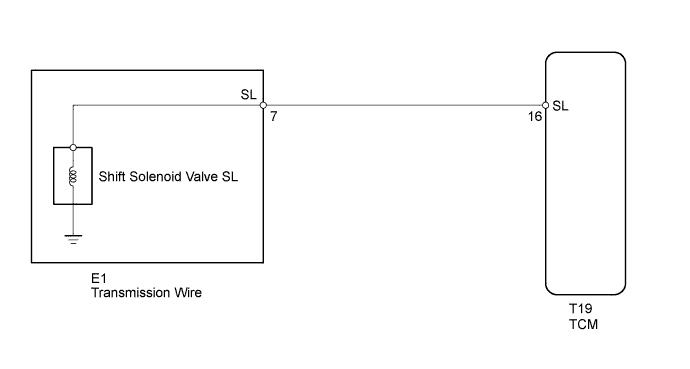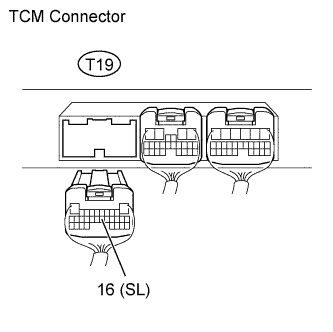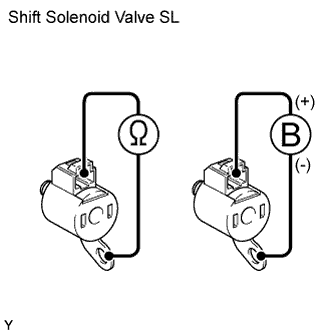Dtc P2769/64 Short In Torque Converter Clutch Solenoid Circuit (Shift Solenoid Valve Sl)
DESCRIPTION
MONITOR DESCRIPTION
WIRING DIAGRAM
INSPECTION PROCEDURE
INSPECT TRANSMISSION WIRE (SHIFT SOLENOID VALVE SL)
CHECK WIRE HARNESS (SHIFT SOLENOID VALVE SL - TCM)
INSPECT SHIFT SOLENOID VALVE SL
DTC P2769/64 Short in Torque Converter Clutch Solenoid Circuit (Shift Solenoid Valve SL) |
DTC P2770/64 Open in Torque Converter Clutch Solenoid Circuit (Shift Solenoid Valve SL) |
DESCRIPTION
The shift solenoid valve SL is turned on and off by signals from the TCM to control the hydraulic pressure acting on the lock-up relay valve, which then controls operation of the lock-up clutch.DTC Code
| DTC Detection Condition
| Trouble Area
|
P2769/64
| TCM detects short in shift solenoid valve SL circuit (once) when shift solenoid valve SL is operated (1 trip detection logic)
| - Short in shift solenoid valve SL circuit
- Shift solenoid valve SL
- TCM
|
P2770/64
| TCM detects open in shift solenoid valve SL circuit (once) when shift solenoid valve SL is not operated (1 trip detection logic)
| - Open in shift solenoid valve SL circuit
- Shift solenoid valve SL
- TCM
|
Fail-safe function:If the TCM detects a malfunction, it turns the shift solenoid valve SL off.
MONITOR DESCRIPTION
Torque converter lock-up is controlled by the TCM based on engine rpm, engine load, engine temperature, vehicle speed, transmission temperature, and shift position selection. The TCM determines the lock-up status of the torque converter by comparing the engine rpm (NE) to the input rpm (NCO). The TCM calculates the actual transmission gear by comparing the input rpm (NCO) to the output rpm (SP2). When conditions are appropriate, the TCM requests "lock-up" by applying control voltage to the shift solenoid valve SL. When the shift solenoid valve SL is opened, the shift solenoid valve SL applies pressure to the lock-up relay valve and locks the torque converter. If the TCM detects an open or short in the shift solenoid valve SL circuit, the TCM interprets this as a fault in the shift solenoid valve SL or its circuit. The TCM will illuminate the MIL and store a DTC.
WIRING DIAGRAM
INSPECTION PROCEDURE
| 1.INSPECT TRANSMISSION WIRE (SHIFT SOLENOID VALVE SL) |
Disconnect the E1 wire connector.
Measure the resistance of the transmission wire.
- Standard Resistance:
Tester Connection
| Condition
| Specified Condition
|
7 (SL) - Body ground
| 20°C (68°F)
| 11 to 15 Ω
|
| 2.CHECK WIRE HARNESS (SHIFT SOLENOID VALVE SL - TCM) |
Disconnect the T19 TCM connector.
Measure the resistance of the wire harness side connector.
- Standard Resistance:
Tester Connection
| Condition
| Specified Condition
|
T19-16 (SL) - Body ground
| 20°C (68°F)
| 11 to 15 Ω
|
| | REPAIR OR REPLACE HARNESS OR CONNECTOR |
|
|
| 3.INSPECT SHIFT SOLENOID VALVE SL |
Remove the shift solenoid valve SL.
Measure the resistance between the solenoid valve terminal and solenoid valve body.
- Standard Resistance:
Tester Connection
| Condition
| Specified Condition
|
Shift solenoid valve SL connector terminal - Shift solenoid valve SL body
| 20°C (68°F)
| 11 to 15 Ω
|
Connect the battery's positive (+) lead to the terminal of the solenoid connector, and the negative (-) lead to the solenoid body.
Check the operating noise of the solenoid valve.
- OK:
- Solenoid makes operating noise.
| | REPLACE SHIFT SOLENOID VALVE SL |
|
|
| OK |
|
|
|
| REPLACE TRANSMISSION WIRE |
|



